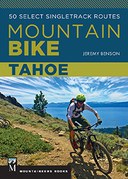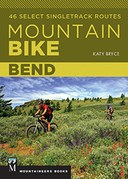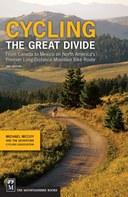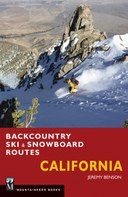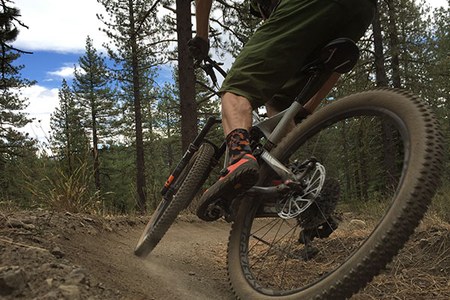
Mountaineers Books author Jeremy Benson takes full advantage of Lake Tahoe, the California mountain bike mecca where he lives. Biking in the warm months and backcountry skiing in the snowy ones, he has both pursued his athletic passions and written about them in Mountain Bike - Tahoe: 50 Select Singletrack Routes and Backcountry Ski & Snowboard Routes: California. Now that the warm months are here, we asked Jeremy what advice he would give to those wanting to get started in mountain biking.
How long have you been mountain biking, and what keeps you engaged in the sport?
I started mountain biking when I was in junior high school, so in the early 1990's. I went to school in Woodbridge, Conn., and there was a modest but fun network of trails in the area. My best friend at the time had a mountain bike, so I talked my Mom into getting me one. I got a Nishiki Pueblo that was a teal color, and I think it cost around $300 brand new at retail. My friend and I explored the trails and we crashed a lot, but I took a liking to the sport. I ended up attending Saint Michael's College just outside of Burlington, Vt. As a freshman I found myself putting on some pounds from being on the meal plan and maybe a little too much partying. I didn't care much for running, so I chose to mountain bike as a fun way to fight off the dreaded "freshman 15". It turned out that there was an excellent trail system accessible right out the back door of my college dorm, so access was incredibly easy. Fitness was the goal, but I quickly got more and more into the sport.
By the end of my sophomore year of college, a friend of mine started a mountain bike club and we started traveling around New England participating in the collegiate XC race circuit. I moved to Lake Tahoe in 2001 after graduating from college, and I've been riding and exploring the trails in the area obsessively ever since. I've always been incredibly passionate about the sport of skiing as well, and living in Tahoe you get the best of both worlds. We have great winters followed by beautiful summers, and mountain biking has just always been what I've done in the warmer months. I've aged out of my pursuit of being a professional/sponsored ski athlete at this point, and my focus has definitely shifted more towards cycling over time.
A few years back I started racing bikes again, and I now compete in the "pro" category in gravel and XC mountain bike races. Racing helps to keep me fit and motivated throughout the season, plus its a heck of a lot of fun. Beyond racing, I just love being out on my bike, whether I'm exploring new trails or riding old favorites. It's an incredible way to get exercise and spend time with friends while getting to see nature at its finest. I also work for a company called OutdoorGearLab as the Senior Mountain Bike Review Editor, so it is my job to test and review the latest and greatest mountain bikes on the market.
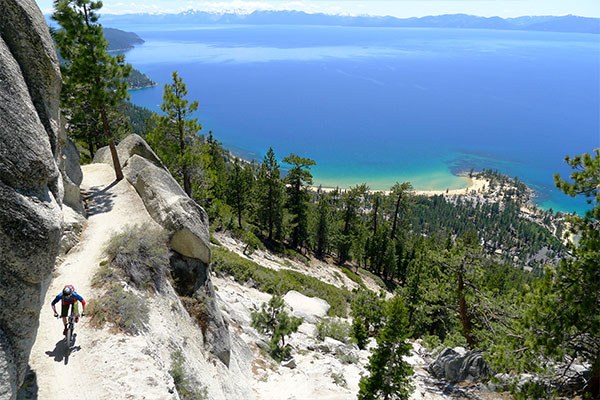
We hear a lot about the different styles of riding – downhill, enduro, all-mountain, cross country. How do new riders find the best style for them?
These days the sport of mountain biking has been broken down into a bunch of different categories. I think as humans we like to categorize things, but at the most basic level, they are all the same, going out and riding your bike for fun. The most common style of riding is trail or all-mountain riding. It's like XC riding with a little more focus on the descents than just all out speed. I think anyone just starting out in the sport should really just start going for trail rides and see where that takes them. Figure out what you like to do and as you progress you'll likely end up focusing on that. If you have friends who ride it's likely that you'll end up doing the same type of riding they're into. I think the most important thing is identifying what you enjoy and what you excel at, and taking it from there. It can be easy as a new rider to get in over your head, so I think its best to start small and work your way up as your fitness and skills allow.
What advice do you have for people who want to get started in mountain biking?
Getting into the sport of mountain biking can definitely seem a little daunting considering the astronomical prices some bikes cost these days. I don't believe that everyone needs to buy a new bike starting out. There are thousands upon thousands of lightly used mountain bikes for sale online and you can often find deals on last year's models.
Additionally, many mountain bike manufacturers are starting to produce quality bikes at lower prices, and you can spend $2,000 or less on a quality bike that will be a blast to ride and will probably last you for several seasons. Do a little research, there is a ton of info and reviews available online. In addition to a bike, a helmet, gloves, sturdy shoes, tools, tubes, and some sort of hydration pack are really all you need to get started.
Helmets are evolving. What would you look for in a helmet?
A helmet is the single most important piece of protective gear you can wear while cycling. No matter what type of riding you do, a helmet may help prevent injury or even death in the event of a crash. Virtually any helmet is better than wearing none at all, but like everything else in the sport, helmet technology continues to progress and there are loads of new materials and protective technologies on the market. Personally, I like extended coverage half-shell helmets that usually have a bit more occipital and temporal lobe coverage than an XC or road bike helmet. There are also several rotational impact protection systems being used these days, like MIPS, SPIN, Turbine 360, and Wavecell, all of which are slightly different but intended to reduce rotational forces on the brain in the event of an oblique impact. It's hard to say exactly how effective these systems are, but I'll take any added safety I can get when it comes to my brain. I also like an adjustable visor to help keep the sun out of my eyes while riding.
Tell us about the drivetrain, suspension, tire size and other features of your favorite mountain bike and why you like that set up.
I ride an Ibis Ripley LS. It has 120mm of rear and 140mm of front suspension, a carbon frame, and 29" wheels. I'm relatively tall, and I've found that I prefer the larger wheel size because it fits my body and riding style a little better than smaller wheel sizes. I run a SRAM X01 Eagle drivetrain, a 170mm dropper seat post, and I like tires in the 2.4"-2.6" width range. I ride a lot of bikes for my job as a mountain bike tester, and I'm always pretty happy to get back on my own because everything is exactly how I like it. Tubeless tires and dropper seat posts have been around for a while now and I believe they are a couple of the most game-changing innovations in mountain biking ever.
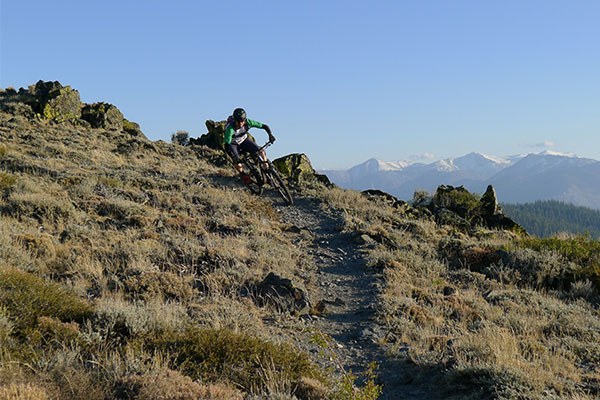
If a rider doesn’t have a navigational computer, is it easy to get lost? Do you ride with a navigation tool, and if so which one?
Navigating while mountain biking can be a challenge depending on where you're riding and your inherent navigational abilities. Twenty years ago we didn't have Trailforks, STRAVA, or cycling computers with preloaded maps, and people managed to find their way through the mountains. Now that these technologies exist, it makes it easier to find your way, but it also makes people less dependent on their own sense of direction than they used to be.
I don't feel that navigation units are essential, though it depends on how well marked the trail system you're riding is, your mental map of an area, or your ability to remember where you came from and retrace a route if necessary. When I first started exploring the trails in Tahoe, I did exactly that. I explored the trails and figured it all out for myself. That said, I do think that navigation units or apps like STRAVA are an excellent tool for most people to use and have made it easier than ever before to find your way in an unfamiliar area.
Nowadays, I'm an avid STRAVA user, and I use a Garmin Edge 520 Plus to track my rides. When I go to new areas I reference Trailforks to figure out where I'm going. Cycling computers are great, but a regular iPhone is just as functional for most riders if you download STRAVA and Trailforks, plus you can take pictures with it and make phone calls in case of an emergency (if you have service)...
What do you have in your backpack and jersey pockets when you are out riding?
I carry quite a few things with me when I ride. Depending on the length of ride I carry between 1.5 and 3 liters of water and a variety of high-calorie snacks. I ride with a fanny pack usually and it has a 1.5 L water bladder in it. I always carry one spare tube, tubeless tire plugs, 3 CO2 canisters, a multi-tool with a chain tool, a quick-link for my chain, multiple zip-ties, and a small first aid kit. I always have my cell phone to take pictures or make emergency phone calls. Depending on the season I may also carry a light jacket and a thin hat to wear under the helmet.
Is mountain biking safe?
I think any sport that is capable of giving you an adrenaline rush like mountain biking will always have an inherent level of danger associated with it. Mountain biking can absolutely be a dangerous sport, but I think that if you approach it with caution and respect for the dangers it can be done safely. I've crashed many hundreds of times while mountain biking, but I enjoy pushing my limits and for me the risk is part of the reward. I can also have a great time just cruising mellow trails and looking at wildflowers. Yes, there are objective hazards out there, but mountain biking is typically only as dangerous as you make it.
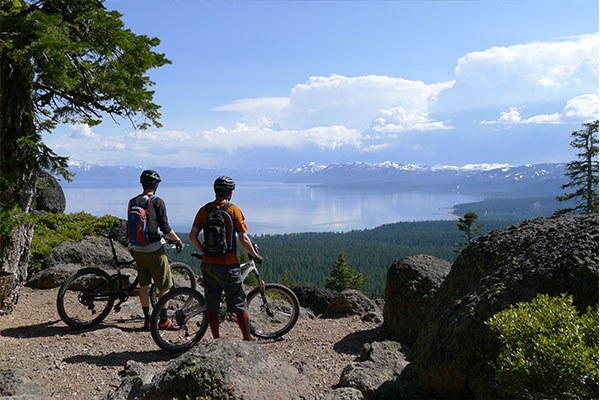
What’s your favorite thing about mountain biking?
I like pretty much everything about mountain biking, but my favorite things about it are the challenge and the escape. I've always enjoyed pushing my personal limits and I've found that mountain biking is the perfect outlet. You can ride the same trail 100 times and still challenge yourself to ride it better or faster than you have before. I also love the escape. When I ride I devote my full attention to the task at hand, and I can let all of my other cares, worries, and thoughts fade into the background for a little while and just be in the moment, it's meditative in a way...
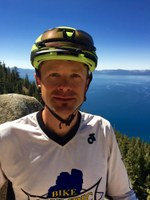 Mountain Bike - Tahoe: 50 Select Singletrack Routes is available wherever books are sold and online right here. Photo at left is Jeremy Benson.
Mountain Bike - Tahoe: 50 Select Singletrack Routes is available wherever books are sold and online right here. Photo at left is Jeremy Benson.
 Mountaineers Books
Mountaineers Books
